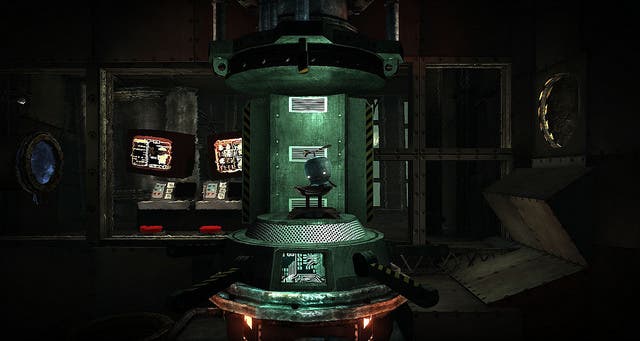Unmechanical: Extended review
Beam me up.
If Unmechanical Extended is home to secrets, then it keeps them well. You play as a stocky robot with pin-light eyes, useless arms, a lantern jaw and a propeller just powerful enough to carry his weight through the air. Together you're lost in a weird, underground world, a warren of caves and control rooms, equal parts natural and mechanized. Deep underground lakes open into futuristic test chambers. Rocks and blobs of pulsing plant matter share space with complicated pipes, oversized cogs, light bulbs and bits of scattered masonry. The walls in one area, near the heart of the place, bleed and throb, as if you're hurtling through someone's arteries - but none of the strangeness is explained. If and when you finally emerge, your reward is mere familiarity with the place, not understanding.
The sense of mystery is compounded by the way in which the game, a physics-based exploration romp that just stops shy of being a full-blown Metroidvania (midway through the four-hour journey you receive a single upgrade to your body that allows you to access previously hidden chambers), requires both natural and industrial-themed solutions to its conundrums. Your only interaction with the world is via a short tractor beam that is able to lift or tug at small objects. During your journey you must use this beam to re-arrange rocks, alter the water level and transport boulders to clear passages through the gameworld. This is the work of the farmhand, manual and earthy. Conversely, you also direct laser beams to reflect across networks of mirrors, balance scales, input codes into giant computers and even mimic rhythmic patterns in an factory-themed music game of Simon Says. The juxtaposition, for all its aesthetic weirdness, works well: the industrial puzzles offer the reassurance that each chamber has a mechanically sound solution while the use of natural assets to solve many of these conundrums implies that there's room for a certain degree of improvisation.
It's true: there is some room for improvisation but in general each of Unmechanical's puzzles has a single solution that's made to feel more dynamic and flexible thanks to the heft and sway of the physics engine. Your robot heaves objects through the air with obvious effort: a heavy battery or explosive mine will swing precariously and, if you let go at the wrong moment, will arc and lodge into some crevice where, with a bit of luck, you'll be able to extract it and try again. The physics is consistent and reliable. Rarely you may even become stuck yourself, not through poor design, but because your robot becomes lodged in the teeth of a cog from which he cannot extract himself. In these cases, you must return to the menu screen and reload a checkpoint to reset his position.

For a one-button physics puzzle game (tractor beam on or tractor beam off) Unmechanical demonstrates surprising depth and variety. Some puzzles are self-contained in solitary rooms, while others spread out across multiple areas, requiring you to travel back and forth. In one of the game's more memorable set-piece puzzles you must bring together two previous solutions to separate puzzles to solve a grander conundrum. It's these more ambitious puzzles that will slow down your progress (as you work out which objects in the area can be manipulated and how they might relate to one another) as, elsewhere, the more straightforward obstacles are more easily cleared.
Unmechanical began as a university student project that grew into the debut release from Swedish studio Talawa Games. For those players left wanting by the somewhat brief and fanfare-less ending(s), this re-release adds a new chapter to bulk out the proposition. Here, your task is more obviously heroic: rescue a robot friend who, during the game's opening scene, is snatched away. As in Portal 2's co-operative missions, the puzzles often work across two plains, as the actions you perform in the foreground aid your friend's progress in the inaccessible background.
The new chapter is welcome but also reveals an idea that had, by the main game's conclusion, perhaps been fully realised. It's telling that the most memorable aspect to the new chapter is when one of your robot's abilities is removed: novelty is introduced by subtraction, not addition. A few structural frustrations remain from the PC original too. There's no level select to return to previous areas (although, in truth, there is almost no reason to return to the game once you'd reached its conclusion) and the game overwrites your saved progress if you decide to try the new mission without having cleared the main storyline.
Unmechanical Extended meets its ambition: the designers fully explore the potential of the template and do so with elegance. But perhaps, in the new context of the newer consoles, that ambition wasn't quite enough. This is a slight, simple, often delightful game that displays moment-to-moment ingenuity but which now obviously lacks a broader conceit to bring its ideas together.

